Descriptive Research: Questionnaire Construction, Administration, Use
VerifiedAdded on 2023/06/03
|5
|1141
|315
Report
AI Summary
This report provides a comprehensive overview of questionnaires as a research instrument, detailing their construction, administration, and application within descriptive research. It distinguishes between open-minded and closed-minded questions, highlighting the four forms of response scales for closed-minded questions: dichotomous, nominal-polytomous, ordinal-polytomous, and continuous. The report emphasizes the importance of logical question flow, clear and unbiased wording, and adherence to grammatical standards. It explores four main models of questionnaire administration: face-to-face, paper and pencil, computer-based, and adaptive computerized administration. Furthermore, it discusses the strengths and weaknesses of using questionnaires, noting their quick and cost-effective nature, as well as challenges related to response reliability and interpretation. The report concludes that questionnaires are an efficient research method, particularly when targeting specific groups, but acknowledges their limitations due to literacy requirements.
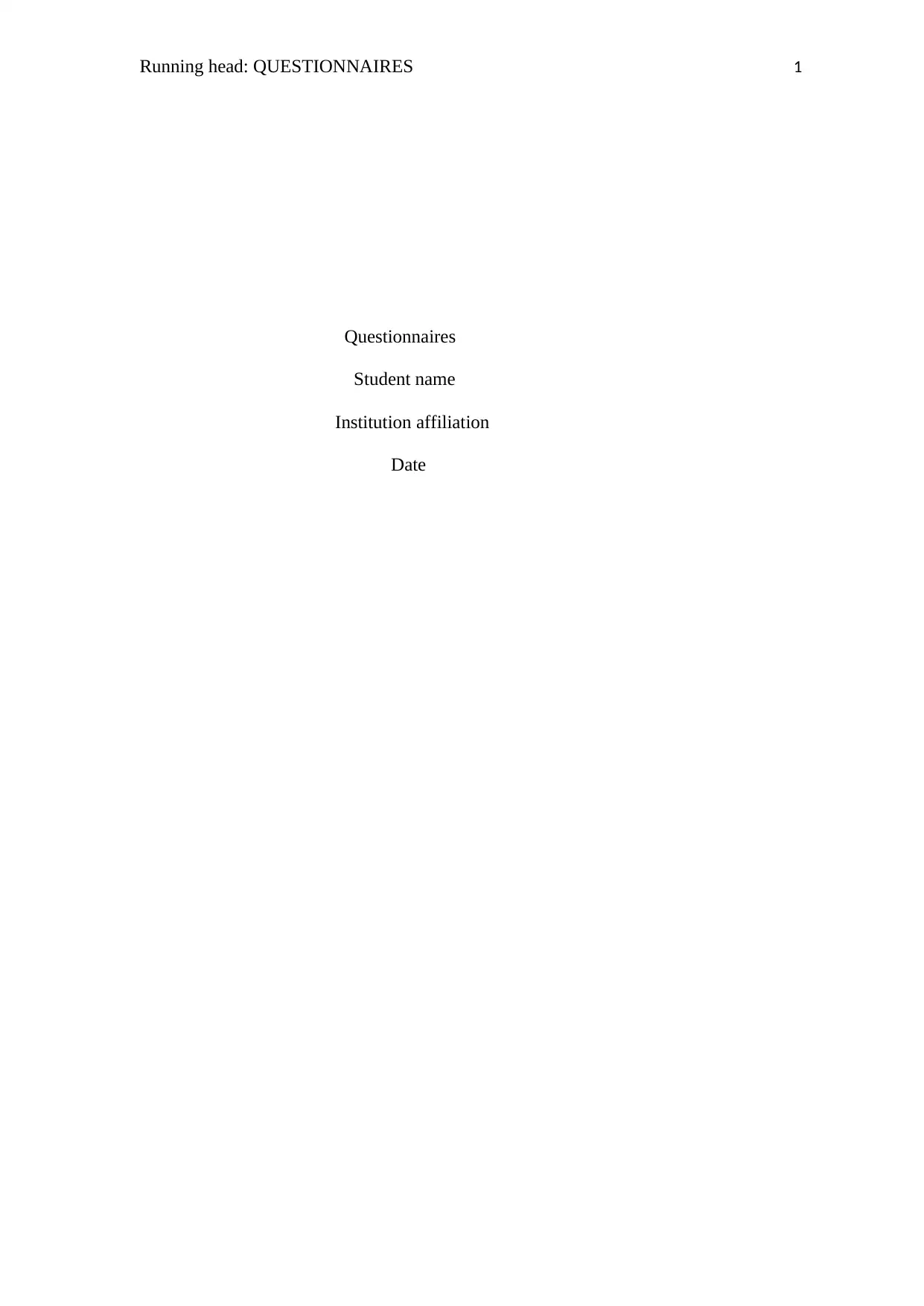
Running head: QUESTIONNAIRES 1
Questionnaires
Student name
Institution affiliation
Date
Questionnaires
Student name
Institution affiliation
Date
Paraphrase This Document
Need a fresh take? Get an instant paraphrase of this document with our AI Paraphraser
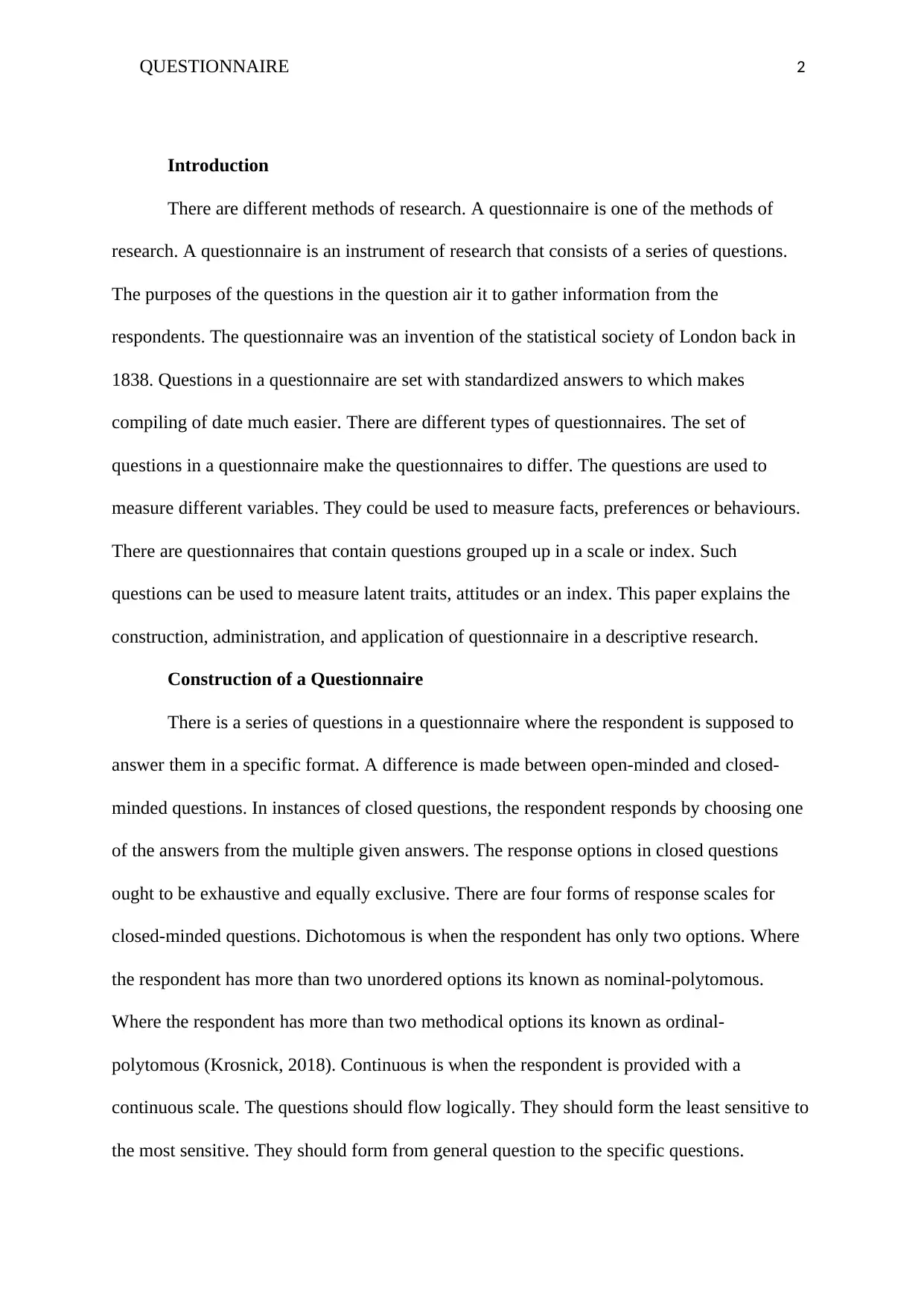
QUESTIONNAIRE 2
Introduction
There are different methods of research. A questionnaire is one of the methods of
research. A questionnaire is an instrument of research that consists of a series of questions.
The purposes of the questions in the question air it to gather information from the
respondents. The questionnaire was an invention of the statistical society of London back in
1838. Questions in a questionnaire are set with standardized answers to which makes
compiling of date much easier. There are different types of questionnaires. The set of
questions in a questionnaire make the questionnaires to differ. The questions are used to
measure different variables. They could be used to measure facts, preferences or behaviours.
There are questionnaires that contain questions grouped up in a scale or index. Such
questions can be used to measure latent traits, attitudes or an index. This paper explains the
construction, administration, and application of questionnaire in a descriptive research.
Construction of a Questionnaire
There is a series of questions in a questionnaire where the respondent is supposed to
answer them in a specific format. A difference is made between open-minded and closed-
minded questions. In instances of closed questions, the respondent responds by choosing one
of the answers from the multiple given answers. The response options in closed questions
ought to be exhaustive and equally exclusive. There are four forms of response scales for
closed-minded questions. Dichotomous is when the respondent has only two options. Where
the respondent has more than two unordered options its known as nominal-polytomous.
Where the respondent has more than two methodical options its known as ordinal-
polytomous (Krosnick, 2018). Continuous is when the respondent is provided with a
continuous scale. The questions should flow logically. They should form the least sensitive to
the most sensitive. They should form from general question to the specific questions.
Introduction
There are different methods of research. A questionnaire is one of the methods of
research. A questionnaire is an instrument of research that consists of a series of questions.
The purposes of the questions in the question air it to gather information from the
respondents. The questionnaire was an invention of the statistical society of London back in
1838. Questions in a questionnaire are set with standardized answers to which makes
compiling of date much easier. There are different types of questionnaires. The set of
questions in a questionnaire make the questionnaires to differ. The questions are used to
measure different variables. They could be used to measure facts, preferences or behaviours.
There are questionnaires that contain questions grouped up in a scale or index. Such
questions can be used to measure latent traits, attitudes or an index. This paper explains the
construction, administration, and application of questionnaire in a descriptive research.
Construction of a Questionnaire
There is a series of questions in a questionnaire where the respondent is supposed to
answer them in a specific format. A difference is made between open-minded and closed-
minded questions. In instances of closed questions, the respondent responds by choosing one
of the answers from the multiple given answers. The response options in closed questions
ought to be exhaustive and equally exclusive. There are four forms of response scales for
closed-minded questions. Dichotomous is when the respondent has only two options. Where
the respondent has more than two unordered options its known as nominal-polytomous.
Where the respondent has more than two methodical options its known as ordinal-
polytomous (Krosnick, 2018). Continuous is when the respondent is provided with a
continuous scale. The questions should flow logically. They should form the least sensitive to
the most sensitive. They should form from general question to the specific questions.
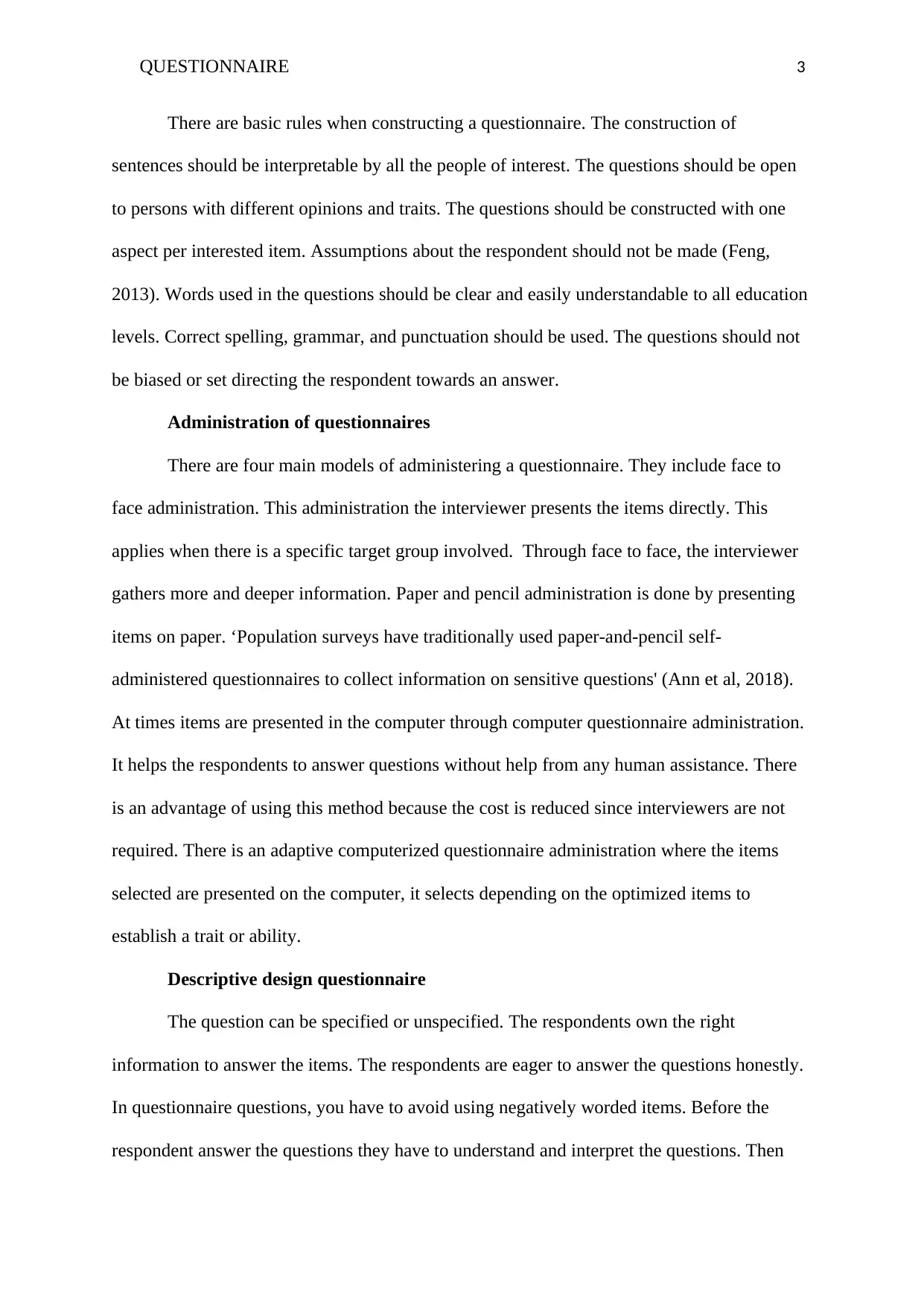
QUESTIONNAIRE 3
There are basic rules when constructing a questionnaire. The construction of
sentences should be interpretable by all the people of interest. The questions should be open
to persons with different opinions and traits. The questions should be constructed with one
aspect per interested item. Assumptions about the respondent should not be made (Feng,
2013). Words used in the questions should be clear and easily understandable to all education
levels. Correct spelling, grammar, and punctuation should be used. The questions should not
be biased or set directing the respondent towards an answer.
Administration of questionnaires
There are four main models of administering a questionnaire. They include face to
face administration. This administration the interviewer presents the items directly. This
applies when there is a specific target group involved. Through face to face, the interviewer
gathers more and deeper information. Paper and pencil administration is done by presenting
items on paper. ‘Population surveys have traditionally used paper-and-pencil self-
administered questionnaires to collect information on sensitive questions' (Ann et al, 2018).
At times items are presented in the computer through computer questionnaire administration.
It helps the respondents to answer questions without help from any human assistance. There
is an advantage of using this method because the cost is reduced since interviewers are not
required. There is an adaptive computerized questionnaire administration where the items
selected are presented on the computer, it selects depending on the optimized items to
establish a trait or ability.
Descriptive design questionnaire
The question can be specified or unspecified. The respondents own the right
information to answer the items. The respondents are eager to answer the questions honestly.
In questionnaire questions, you have to avoid using negatively worded items. Before the
respondent answer the questions they have to understand and interpret the questions. Then
There are basic rules when constructing a questionnaire. The construction of
sentences should be interpretable by all the people of interest. The questions should be open
to persons with different opinions and traits. The questions should be constructed with one
aspect per interested item. Assumptions about the respondent should not be made (Feng,
2013). Words used in the questions should be clear and easily understandable to all education
levels. Correct spelling, grammar, and punctuation should be used. The questions should not
be biased or set directing the respondent towards an answer.
Administration of questionnaires
There are four main models of administering a questionnaire. They include face to
face administration. This administration the interviewer presents the items directly. This
applies when there is a specific target group involved. Through face to face, the interviewer
gathers more and deeper information. Paper and pencil administration is done by presenting
items on paper. ‘Population surveys have traditionally used paper-and-pencil self-
administered questionnaires to collect information on sensitive questions' (Ann et al, 2018).
At times items are presented in the computer through computer questionnaire administration.
It helps the respondents to answer questions without help from any human assistance. There
is an advantage of using this method because the cost is reduced since interviewers are not
required. There is an adaptive computerized questionnaire administration where the items
selected are presented on the computer, it selects depending on the optimized items to
establish a trait or ability.
Descriptive design questionnaire
The question can be specified or unspecified. The respondents own the right
information to answer the items. The respondents are eager to answer the questions honestly.
In questionnaire questions, you have to avoid using negatively worded items. Before the
respondent answer the questions they have to understand and interpret the questions. Then
⊘ This is a preview!⊘
Do you want full access?
Subscribe today to unlock all pages.

Trusted by 1+ million students worldwide
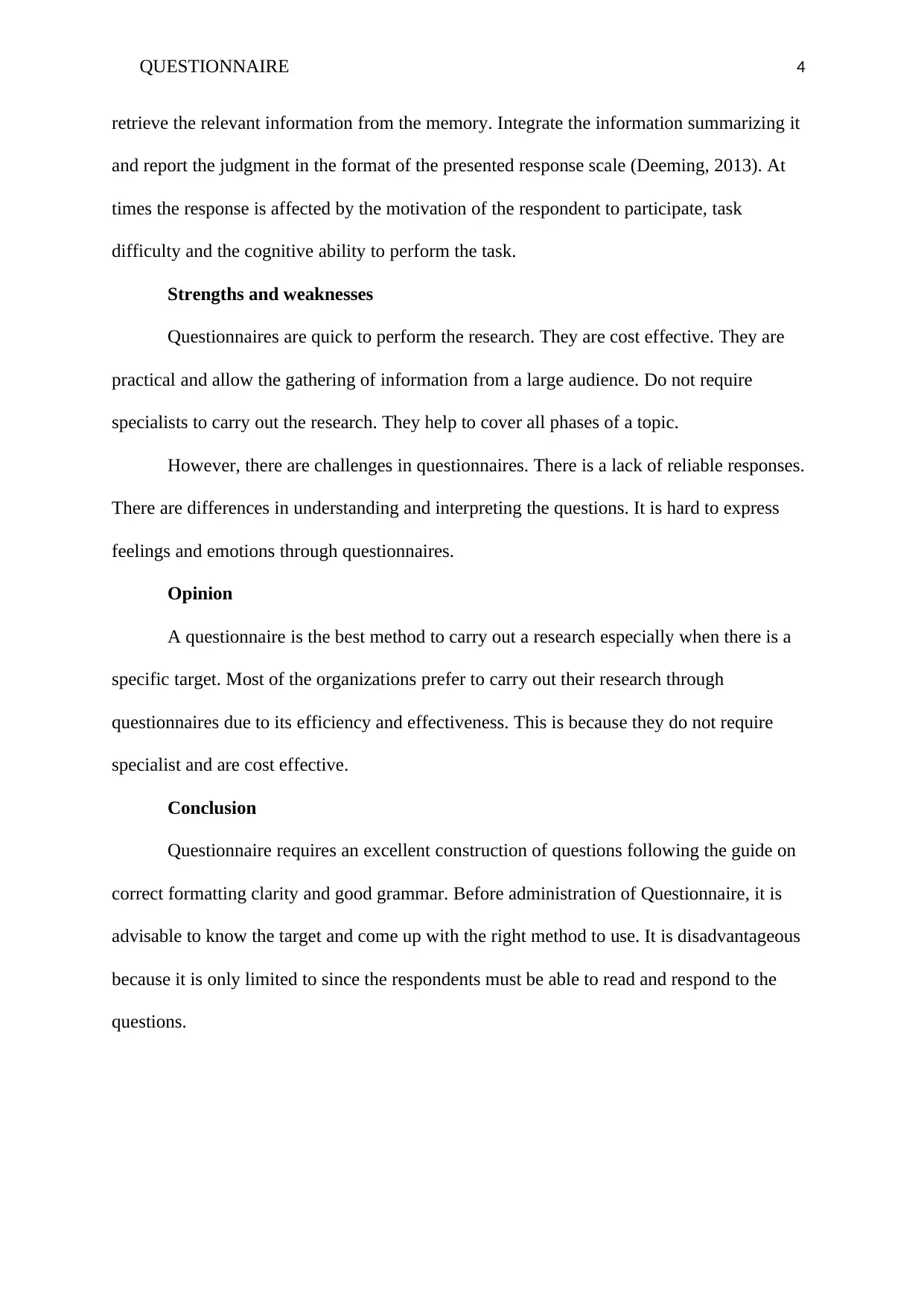
QUESTIONNAIRE 4
retrieve the relevant information from the memory. Integrate the information summarizing it
and report the judgment in the format of the presented response scale (Deeming, 2013). At
times the response is affected by the motivation of the respondent to participate, task
difficulty and the cognitive ability to perform the task.
Strengths and weaknesses
Questionnaires are quick to perform the research. They are cost effective. They are
practical and allow the gathering of information from a large audience. Do not require
specialists to carry out the research. They help to cover all phases of a topic.
However, there are challenges in questionnaires. There is a lack of reliable responses.
There are differences in understanding and interpreting the questions. It is hard to express
feelings and emotions through questionnaires.
Opinion
A questionnaire is the best method to carry out a research especially when there is a
specific target. Most of the organizations prefer to carry out their research through
questionnaires due to its efficiency and effectiveness. This is because they do not require
specialist and are cost effective.
Conclusion
Questionnaire requires an excellent construction of questions following the guide on
correct formatting clarity and good grammar. Before administration of Questionnaire, it is
advisable to know the target and come up with the right method to use. It is disadvantageous
because it is only limited to since the respondents must be able to read and respond to the
questions.
retrieve the relevant information from the memory. Integrate the information summarizing it
and report the judgment in the format of the presented response scale (Deeming, 2013). At
times the response is affected by the motivation of the respondent to participate, task
difficulty and the cognitive ability to perform the task.
Strengths and weaknesses
Questionnaires are quick to perform the research. They are cost effective. They are
practical and allow the gathering of information from a large audience. Do not require
specialists to carry out the research. They help to cover all phases of a topic.
However, there are challenges in questionnaires. There is a lack of reliable responses.
There are differences in understanding and interpreting the questions. It is hard to express
feelings and emotions through questionnaires.
Opinion
A questionnaire is the best method to carry out a research especially when there is a
specific target. Most of the organizations prefer to carry out their research through
questionnaires due to its efficiency and effectiveness. This is because they do not require
specialist and are cost effective.
Conclusion
Questionnaire requires an excellent construction of questions following the guide on
correct formatting clarity and good grammar. Before administration of Questionnaire, it is
advisable to know the target and come up with the right method to use. It is disadvantageous
because it is only limited to since the respondents must be able to read and respond to the
questions.
Paraphrase This Document
Need a fresh take? Get an instant paraphrase of this document with our AI Paraphraser
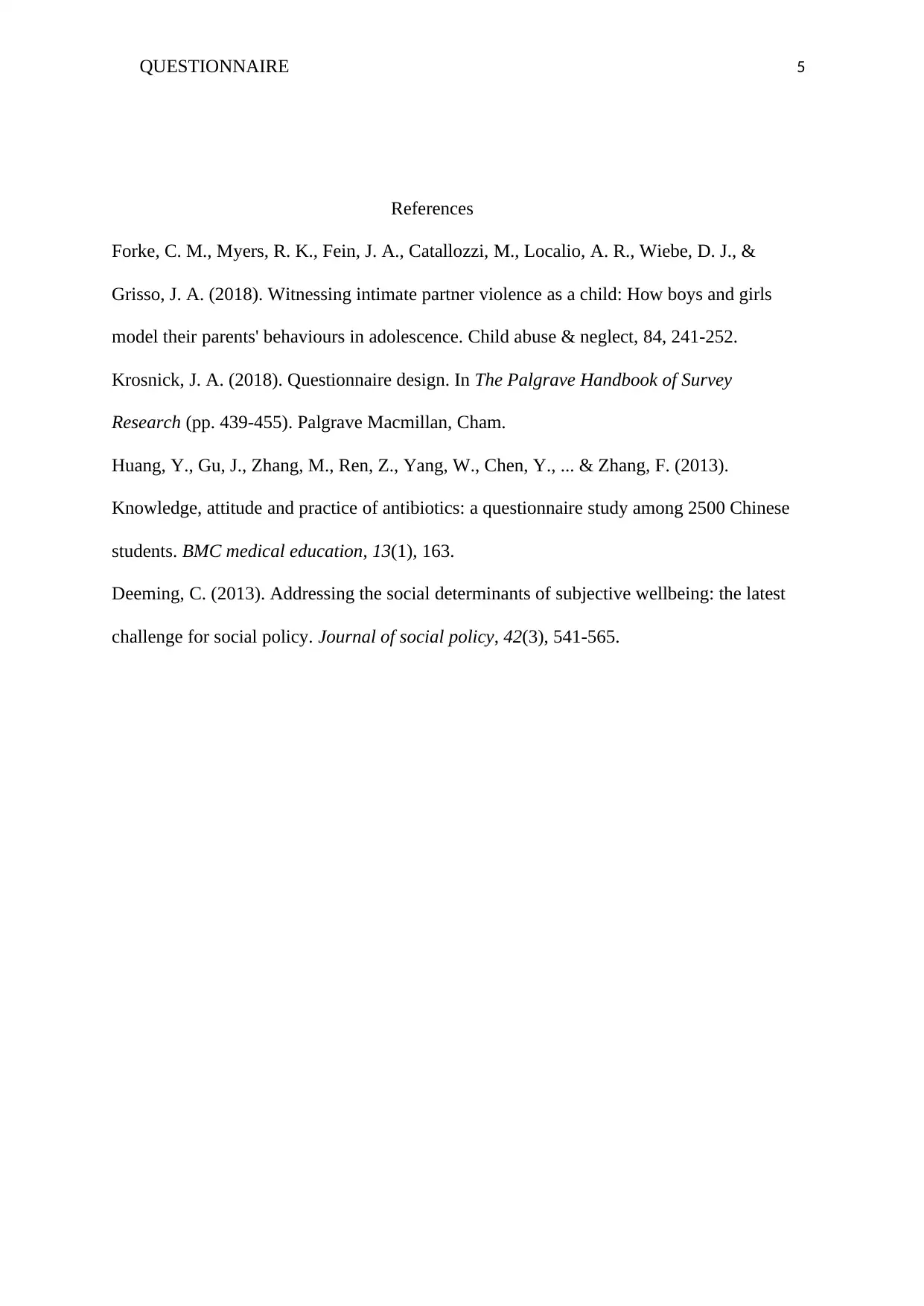
QUESTIONNAIRE 5
References
Forke, C. M., Myers, R. K., Fein, J. A., Catallozzi, M., Localio, A. R., Wiebe, D. J., &
Grisso, J. A. (2018). Witnessing intimate partner violence as a child: How boys and girls
model their parents' behaviours in adolescence. Child abuse & neglect, 84, 241-252.
Krosnick, J. A. (2018). Questionnaire design. In The Palgrave Handbook of Survey
Research (pp. 439-455). Palgrave Macmillan, Cham.
Huang, Y., Gu, J., Zhang, M., Ren, Z., Yang, W., Chen, Y., ... & Zhang, F. (2013).
Knowledge, attitude and practice of antibiotics: a questionnaire study among 2500 Chinese
students. BMC medical education, 13(1), 163.
Deeming, C. (2013). Addressing the social determinants of subjective wellbeing: the latest
challenge for social policy. Journal of social policy, 42(3), 541-565.
References
Forke, C. M., Myers, R. K., Fein, J. A., Catallozzi, M., Localio, A. R., Wiebe, D. J., &
Grisso, J. A. (2018). Witnessing intimate partner violence as a child: How boys and girls
model their parents' behaviours in adolescence. Child abuse & neglect, 84, 241-252.
Krosnick, J. A. (2018). Questionnaire design. In The Palgrave Handbook of Survey
Research (pp. 439-455). Palgrave Macmillan, Cham.
Huang, Y., Gu, J., Zhang, M., Ren, Z., Yang, W., Chen, Y., ... & Zhang, F. (2013).
Knowledge, attitude and practice of antibiotics: a questionnaire study among 2500 Chinese
students. BMC medical education, 13(1), 163.
Deeming, C. (2013). Addressing the social determinants of subjective wellbeing: the latest
challenge for social policy. Journal of social policy, 42(3), 541-565.
1 out of 5
Related Documents
Your All-in-One AI-Powered Toolkit for Academic Success.
+13062052269
info@desklib.com
Available 24*7 on WhatsApp / Email
![[object Object]](/_next/static/media/star-bottom.7253800d.svg)
Unlock your academic potential
Copyright © 2020–2026 A2Z Services. All Rights Reserved. Developed and managed by ZUCOL.




